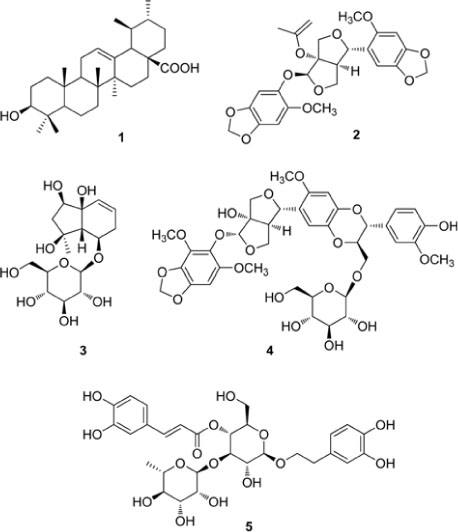Nat Prod Sci.
2019 Mar;25(1):34-37. 10.20307/nps.2019.25.1.34.
Isolation of Constituents with Nitric Oxide Synthase Inhibition Activity from Phryma leptostachya var. asiatica
- Affiliations
-
- 1College of Pharmacy, Seoul National University, Seoul 08826, Korea.
- 2College of Oriental Medicine, Sangji University, Wonju 26339, Korea.
- 3Department of Pharmaceutical Engineering, Sangji University, Wonju 26339, Korea. hjpark@sangji.ac.kr
- KMID: 2443101
- DOI: http://doi.org/10.20307/nps.2019.25.1.34
Abstract
- Phytochemical studies were performed to identify the active principles of Phryma leptostachya var. asiatica (Phyrymaceae) for anti-inflammation. The anti-inflammatory activity was assessed by measuring the inhibition rate on nitric oxide (NO) formation in lipopolysaccharide (LPS)-activated macrophage 264.7 cells. Of the five compounds including ursolic acid, phrymarolin I, harpagide, haedoxancoside A, and acteoside isolated from this plant, ursolic acid showed the most prominent inhibition of NO formation. Therefore, ursolic acid may be the anti-inflammatory principle of Phryma leptostachya var. asiatica.
Keyword
Figure
Reference
-
1. Jung HJ, Cho YW, Lim HW, Choi H, Ji DJ, Lim CJ. Biomol Ther. 2013; 21:72–78.2. Tanigichi E, Oshima Y. Agric Biol Chem. 1972; 36:1013–1025.3. Taniguchi E, Oshima Y. Agric Biol Chem. 1972; 36:1489–1496.4. Xiao X, Ji Z, Zhang J, Shi B, Wei S, Wu W. Chem Nat Comp. 2013; 49:21–23.5. Chen C, Zhu H, Zhao D, Deng J, Zhang Y. Helv Chim Acta. 2013; 96:1392–1396.6. Lee S, Min B, Kho Y. Arch Pharm Res. 2002; 25:652–654.7. Seo SM, Park IK. Parasitol Res. 2012; 110:1849–1853.8. Park IK, Shin SC, Kim CS, Lee HJ, Choi WS, Ahn YJ. J Agric Food Chem. 2005; 53:969–972.9. Singh VK, Mehrotra S, Narayan P, Pandey CM, Agarwal SS. Immunol Res. 2000; 22:1–19.10. Chesrown SE, Monnier J, Visner G, Nick HS. Biochem Biophys Res Commun. 1994; 200:126–134.11. Manguro LOA, Lemmen P, Hao P. Rec Nat Prod. 2011; 5:147–157.12. Schlauer J, Budzianowski J, Kukulczanka K, Ratajczak L. Acta Soc Bot Pol. 2004; 73:9–15.13. Park HJ, Jung WT, Basnet P, Kadota S, Namba T. J Nat Prod. 1996; 59:1128–1130.14. Kim MH, Kim JN, Han SN, Kim HK. Immunopharmacol Immunotoxicol. 2015; 37:228–235.15. Li Q, Dong DD, Huang QP, Li J, Du YY, Li B, Li HQ, Huyan T. Pharm Biol. 2017; 55:799–809.
- Full Text Links
- Actions
-
Cited
- CITED
-
- Close
- Share
- Similar articles
-
- Anti-Inflammatory, Antioxidant, Anti-Angiogenic and Skin Whitening Activities of Phryma leptostachya var. asiatica Hara Extract
- Nitric Oxide Synthase Inhibition Alters Extracellular Glutamate Concentration after Global Cerebral Ischemia
- Role of nitric oxide and distribution of nitric oxide synthase in the gustatory system
- Distribution of Nitric Oxide Synthase Isoforms in Perioral Exocrine Glands in Rats
- Involvement of Fibronectin in the Migration of Macrophage and Expression of Nitric Oxide Synthase in the BCG induced Inflammatory Sites in Rat Bladder



